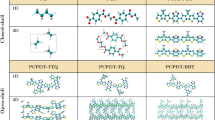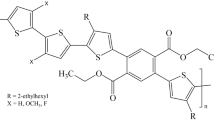Abstract
We systematically investigated and compared the electronic band gaps of 16 different donor-acceptor-donor type semiconducting polymer systems that included different chalcogen atoms in their donor and acceptor units. The five-membered heterocyclic rings furan, thiophene, selenophene, and tellurophene were considered as electron donor units, whereas benzochalcogenadiazole groups, i.e., benzoxadiazole, benzothiadiazole, benzoselenadiazole, and benzotelluradiazole, were used as electron acceptor units. Our findings from B3LYP/6-31G(d) and B3LYP/LANL2DZ calculations performed with and without the polarizable continuum model indicated that the size of the chalcogen atom used as a heteroatom in the donor units plays a more important role than the size of the chalcogen atom in the benzochalcogenadiazole acceptor unit does. On the other hand, our results also suggest that the best way to modify and narrow the electronic band gap is to use heavy chalcogen atoms in both donor and acceptor units.




Similar content being viewed by others
References
Chiang CK, Fincher CR, Park YW et al (1977) Electrical conductivity in doped polyacetylene. Phys Rev Lett 39:1098–1101
Chiang CK, Fincher CR, Park YW et al (1978) Electrical conductivity in doped polyacetylene. Phys Rev Lett 40:1472
Strobl GR (2007) The physics of polymers: concepts for understanding their structures and behavior. Springer, Berlin
Chandrasekhar P, Zay BJ, Birur GC et al (2002) Large, switchable electrochromism in the visible through far-infrared in conducting polymer devices. Adv Funct Mater 12:95–103. https://doi.org/10.1002/1616-3028(20020201)12:2<95::aid-adfm95>3.0.co;2-n
Beaujuge PM, Reynolds JR (2010) Color control in π-conjugated organic polymers for use in electrochromic devices. Chem Rev 110:268–320. https://doi.org/10.1021/cr900129a
Su YS, Wu TY (2017) Three carbazole-based polymers as potential anodically coloring materials for high-contrast electrochromic devices. Polymers (Basel) 9:284. https://doi.org/10.3390/polym9070284
Muccini M (2006) A bright future for organic field-effect transistors. Nat Mater 5:605–613
Yang C, Kim JY, Cho S et al (2008) Functionalized methanofullerenes used as n-type materials in bulk-heterojunction polymer solar cells and in field-effect transistors. J Am Chem Soc 130:6444–6450. https://doi.org/10.1021/ja710621j
Yuan Z, Buckley C, Thomas S et al (2018) A thiazole–naphthalene diimide based n-channel donor–acceptor conjugated polymer. Macromolecules 51:7320–7328. https://doi.org/10.1021/acs.macromol.8b01829
Liu F, Wang H, Zhang Y et al (2019) Synthesis of low band-gap 2D conjugated polymers and their application for organic field effect transistors and solar cells. Org Electron 64:27–36. https://doi.org/10.1016/j.orgel.2018.09.032
Greenham NC, Moratti SC, Bradley DDC et al (1993) Efficient light-emitting diodes based on polymers with high electron affinities. Nature 365:628–630
Santos LF, Gozzi G (2016) Electrical properties of polymer light-emitting devices. In: Yılmaz F (ed) Conducting polymers. InTech, London, pp 335–343
Herrera M, Abdul-Moqueet M, Mahmoud MA (2019) Conjugated polymer nanoparticles having modified band gaps assembled into nano- and micropatterned organic light-emitting diodes. ACS Appl Nano Mater 2:577–585. https://doi.org/10.1021/acsanm.8b02175
Franco FC, Padama AAB (2016) DFT and TD-DFT study on the structural and optoelectronic characteristics of chemically modified donor-acceptor conjugated oligomers for organic polymer solar cells. Polymer (Guildf) 97:55–62. https://doi.org/10.1016/j.polymer.2016.05.025
Yin Y, Zhang Y, Zhao L (2018) Indaceno-based conjugated polymers for polymer solar cells. Macromol Rapid Commun 39:1700697. https://doi.org/10.1002/marc.201700697
He A, Qin Y, Dai W, Luo X (2019) Novel D-A type dyes based on BODIPY for solution processed organic polymer solar cells. Dyes Pigments 162:671–679. https://doi.org/10.1016/j.dyepig.2018.10.068
Bredas J-L (2014) Mind the gap! Mater Horiz 1:17–19. https://doi.org/10.1039/C3MH00098B
Skotheim TA, Reynolds J (2007) Handbook of conducting polymers. CRC Press, Boca Raton
Distefano G, Jones D, Guerra M et al (1991) Determination of the electronic structure of oligofurans and extrapolation to polyfuran. J Phys Chem 95:9746–9753. https://doi.org/10.1021/j100177a028
McConnell R, Godwin W, Baker S et al (2004) Polyfuran and co-polymers: a chemical synthesis. Int J Polym Mater 53:697–708. https://doi.org/10.1080/00914030490472908
Kirkpatrick J, Nielsen CB, Zhang W et al (2012) A systematic approach to the design optimization of light-absorbing indenofluorene polymers for organic photovoltaics. Adv Energy Mater 2:260–265. https://doi.org/10.1002/aenm.201100622
Roncali J (2007) Molecular engineering of the band gap of π-conjugated systems: facing technological applications. Macromol Rapid Commun 28:1761–1775. https://doi.org/10.1002/marc.200700345
Zhu Y, Champion RD, Jenekhe SA (2006) Conjugated donor-acceptor copolymer semiconductors with large intramolecular charge transfer: synthesis, optical properties, electrochemistry, and field effect carrier mobility of thienopyrazine-based copolymers. Macromolecules 39:8712–8719. https://doi.org/10.1021/ma061861g
Steckler TT, Abboud KA, Craps M et al (2007) Low band gap EDOT-benzobis(thiadiazole) hybrid polymer characterized on near-IR transmissive single walled carbon nanotube electrodes. Chem Commun (Camb) 4:4904–4906. https://doi.org/10.1039/b709672k
Beaujuge PM, Ellinger S, Reynolds JR (2008) The donor-acceptor approach allows a black-to-transmissive switching polymeric electrochrome. Nat Mater 7:795–799. https://doi.org/10.1038/nmat2272
Pati PB, Senanayak SP, Narayan KS, Zade SS (2013) Solution processable benzooxadiazole and benzothiadiazole based D-A-D molecules with chalcogenophene: field effect transistor study and structure property relationship. ACS Appl Mater Interfaces 5:12460–12468. https://doi.org/10.1021/am403559a
Pati PB, Das S, Zade SS (2012) Benzooxadiazaole-based D-A-D co-oligomers: synthesis and electropolymerization. J Polym Sci Part A Polym Chem 50:3996–4003. https://doi.org/10.1002/pola.26195
İçli-Özkut M, İpek H, Karabay B et al (2013) Furan and benzochalcogenodiazole based multichromic polymers via a donor–acceptor approach. Polym Chem 4:2457–2463. https://doi.org/10.1039/c3py21061h
Acharya R, Cekli S, Zeman CJ et al (2016) Effect of selenium substitution on intersystem crossing in π-conjugated donor-acceptor-donor chromophores: the LUMO matters the most. J Phys Chem Lett 7:693–697. https://doi.org/10.1021/acs.jpclett.5b02902
Cihaner A, Algi F (2008) A novel neutral state green polymeric electrochromic with superior n- and p-doping processes: closer to red-blue-green (RGB) display realization. Adv Funct Mater 18:3583–3589. https://doi.org/10.1002/adfm.200801094
Sun X, Lei XL, Qi CH, Hu Y (2013) The new synthesis of 4,7-dithienyl[2,1,3]-benzoselenadiazole. Adv Mater Res 781–784:440–443. https://doi.org/10.4028/www.scientific.net/AMR.781-784.440
Sun X, Lei X, Hu Y (2015) Synthesis and characterization of conjugated polymers based on benzoselenadiazole. Asian J Chem 27:2427–2430. https://doi.org/10.14233/ajchem.2015.17885
McCormick TM, Bridges CR, Carrera EI et al (2013) Conjugated polymers: evaluating DFT methods for more accurate orbital energy modeling. Macromolecules 46:3879–3886. https://doi.org/10.1021/ma4005023
Blouin N, Michaud A, Gendron D et al (2008) Toward a rational design of poly(2,7-carbazole) derivatives for solar cells. J Am Chem Soc 130:732–742. https://doi.org/10.1021/ja0771989
Kayi H (2014) A computational study on 4,7-di(furan-2-yl)benzo[c][1,2,5] thiadiazole monomer and its oligomers. J Mol Model 20:2269. https://doi.org/10.1007/s00894-014-2269-6
Kayi H, Elkamel A (2015) A theoretical investigation of 4,7-di(furan-2-yl)benzo[c][1,2,5]selenadiazole-based donor-acceptor type conjugated polymer. Comput Theor Chem 1054:38–45
Kaya B, Kayi H (2017) Design of novel tellurium and selenium containing semiconducting polymers using quantum mechanical tools. Comput Theor Chem 1099:45–54. https://doi.org/10.1016/j.comptc.2016.11.014
Becke AD (1988) Density-functional exchange-energy approximation with correct asymptotic behavior. Phys Rev A Gen Phys 38:3098–3100
Lee C, Yang W, Parr RG (1988) Development of the Colle–Salvetti correlation-energy formula into a functional of the electron density. Phys Rev B Condens Matter 37:785–789
Becke AD (1993) Density-functional thermochemistry. III. The role of exact exchange. J Chem Phys 98:5648–5652
Hay PJ, Wadt WR (1985) Ab initio effective core potentials for molecular calculations. Potentials for K to Au including the outermost core orbitals. J Chem Phys 82:299–310. https://doi.org/10.1063/1.448975
Wadt WR, Hay PJ (1985) Ab initio effective core potentials for molecular calculations. Potentials for main group elements Na to Bi. J Chem Phys 82:284–298. https://doi.org/10.1063/1.448800
Ditchfield R, Hehre WJ, Pople JA (1971) Self-consistent molecular-orbital methods. IX. Extended Gaussian-type basis for molecular-orbital studies of organic molecules. J Chem Phys 54:724–728
Hehre WJ, Ditchfield R, Pople JA (1972) Self-consistent molecular orbital methods. XII. Further extensions of Gaussian-type basis sets for use in molecular orbital studies of organic molecules. J Chem Phys 56:2257–2261
Hariharan PC, Pople JA (1973) Influence of polarization functions on MO hydrogenation energies. Theor Chim Acta 28:213–222
Hariharan PC, Pople JA (1974) Accuracy of AHn equilibrium geometries by single determinant molecular orbital theory. Mol Phys 27:209–213
Miertuš S, Scrocco E, Tomasi J (1981) Electrostatic interaction of a solute with a continuum. A direct utilizaion of AB initio molecular potentials for the prevision of solvent effects. Chem Phys 55:117–129. https://doi.org/10.1016/0301-0104(81)85090-2
Miertuš S, Tomasi J (1982) Approximate evaluations of the electrostatic free energy and internal energy changes in solution processes. Chem Phys 65:239–245. https://doi.org/10.1016/0301-0104(82)85072-6
Pascual-ahuir JL, Silla E, Tuñon I (1994) GEPOL: an improved description of molecular surfaces. III. A new algorithm for the computation of a solvent-excluding surface. J Comput Chem 15:1127–1138. https://doi.org/10.1002/jcc.540151009
Cossi M, Barone V, Cammi R, Tomasi J (1996) Ab initio study of solvated molecules: a new implementation of the polarizable continuum model. Chem Phys Lett 255:327–335. https://doi.org/10.1016/0009-2614(96)00349-1
Barone V, Cossi M, Tomasi J (1997) A new definition of cavities for the computation of solvation free energies by the polarizable continuum model. J Chem Phys 107:3210–3221. https://doi.org/10.1063/1.474671
Cancès E, Mennucci B, Tomasi J (1997) A new integral equation formalism for the polarizable continuum model: theoretical background and applications to isotropic and anisotropic dielectrics. J Chem Phys 107:3032–3041. https://doi.org/10.1063/1.474659
Frisch MJ, Trucks GW, Schlegel HB, et al (2013) Gaussian 09, rev. D.01. Gaussian Inc., Wallingford
Dennington R, Keith T, Millam J (2009) GaussView, ver. 5.0.8. Semichem Inc., Shawnee Mission
Acknowledgements
The authors acknowledge the Scientific and Technological Research Council of Turkey (TUBITAK) for providing financial support for this study under grant no. 117Z354. The authors also would like to thank Besim Baranoğlu of the Computational Science and Engineering Laboratory at Atilim University for providing computational resources.
Last but not least, Dr. Kayı would like to express his deepest gratitude to his “Doktorvater” Professor Timothy Clark for his endless support and inspiration. This paper is dedicated to Tim on the occasion of his 70th birthday.
Author information
Authors and Affiliations
Corresponding author
Additional information
Publisher’s note
Springer Nature remains neutral with regard to jurisdictional claims in published maps and institutional affiliations.
This paper belongs to the Topical Collection Tim Clark 70th Birthday Festschrift
Electronic supplementary material
ESM 1
(DOCX 16563 kb)
Rights and permissions
About this article
Cite this article
Ozkilinc, O., Kayi, H. Effect of chalcogen atoms on the electronic band gaps of donor-acceptor-donor type semiconducting polymers: a systematic DFT investigation. J Mol Model 25, 167 (2019). https://doi.org/10.1007/s00894-019-4043-2
Received:
Accepted:
Published:
DOI: https://doi.org/10.1007/s00894-019-4043-2




